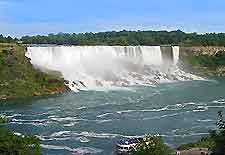Niagara Falls History Facts and Timeline
(Niagara Falls, Ontario, Canada)

The history of Canada's Niagara Falls city is very much a side attraction to the plunging falls themselves. Various groups were drawn to the falls and a town grew on the site of today's city, as a result of the river and the railway.
Aside from being a major tourist destination, the city is a lucrative base for industry thanks to the development of hydroelectric power.
Earliest Inhabitants
Attracted by the falls, the Iroquois Indians from
New York State, followed by Europeans and Unionists, were the first settlers of the area now known as Niagara Falls. Belgian priest Louis Hennepin was supposedly the first European to describe the falls fully (in the 1670s), although others certainly visited this world wonder before him.
The area got busier when Loyalists of the Empire came in droves at the time of the American Revolution, with well-known pioneer families, the Lundys and the Benders, settling the Niagara River's west bank. The Portage Road and the Chippawa Creek areas also developed into communities.
Prior to becoming the town named Niagara Falls, the community of Clifton joined forces with the rapidly expanding village of Elgin, which grew out of present-day Bridge Street. The latter village expanded quickly before joining Clifton, which itself was incorporated in the 1850s, with its name changed to Niagara Falls in 1881. Thereafter, Drummondville (Niagara Falls South) was also amalgamated.
Tourism and Industry
Tourism was realized early on, with folk flocking in from all corners of the globe to see the falls at a then full flow - today they are somewhat throttled (particularly at night), as water is diverted to the hydro plants.
The roaring Niagara River was eventually spanned by a bridge in 1848, after which time the Great Western Railway reached Hamilton. The bridge was later expanded to include lanes for foot and horse-drawn traffic beneath the rail line. The route became busy owing to increased trade between
Toronto and
New York.
Hydroelectric power potential was recognized and various waterwheels and plants have been setup along the Niagara River over the years. Today, a huge hydroelectric project diverts water from the river through tunnels to the plant farther downstream, thus preserving the river and the falls.
Town and Fort
Stamford Township became part of Niagara Falls in 1962, an event which effectively doubled the populace, while Chippawa village, Willoughby and Crowland were absorbed in the 1970s. The city itself lacks historical splendor, although the nearby Old Fort Erie, in the town of Fort Erie (to the south), attracts many tourists. Built after the Seven Years' War with France, the fort saw a lot of action during the War of 1812. It has preserved its period features and today puts on regular battle re-enactments.
Modern Niagara
Hailing from the 1960s, the Minolta Tower in the city center is one of Niagara Falls' latter-day tourist sights, while the IMAX theater on Fallsview Boulevard relays the history of Niagara Falls. Many visitors interested in the history of the region also take in the nearby town of
Niagara on the Lake, a pleasant community that features the historic Pumphouse Visual Art Center.
Not surprisingly there is something of a 'Vegas' character to the city, even in the winter months when the falls are largely frozen over. The city today, while still a side attraction to the falls, is a premier honeymoon destination, as well as a popular entertainment destination for its casino, amusement venues and offbeat Clifton Hill attractions.
 The history of Canada's Niagara Falls city is very much a side attraction to the plunging falls themselves. Various groups were drawn to the falls and a town grew on the site of today's city, as a result of the river and the railway.
The history of Canada's Niagara Falls city is very much a side attraction to the plunging falls themselves. Various groups were drawn to the falls and a town grew on the site of today's city, as a result of the river and the railway.